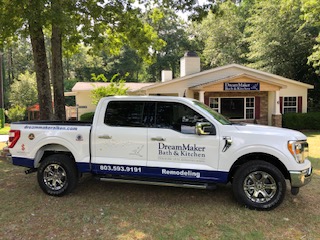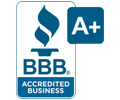

Let me briefly introduce myself. My name is JD Norris, owner, and operator of the DreamMaker Bath and Kitchen Franchise in the Aiken/Augusta area.
Over the years I’ve noticed a common thread in the Sales process of professional remodeling, and that is most clients assume all things are equal. By that, I mean they assume all contractors operate their business in the same manner, provide the same level of service, they all have someone to mysteriously answer their calls, they all have their own employees, and all communicate extremely well, etc. etc.
The assumption is that service companies are just like commodities. Nothing could be or is actually further from the truth. The question prospective clients need to ask themselves is when do they want to find out the truth? BEFORE they make a commitment to spend tens of thousands of dollars or AFTER they’ve made that commitment?
That is why we at DreamMaker Bath and Kitchen, have chosen to hold a “Discovery Meeting” before running all over town meeting in prospects home, measuring, talking a good game, and running off to the next meeting. Not fully comprehending the goals, needs, priorities and even budget that the client needs or wants.
As Design/Build Remodelers, we owe it to our prospective clients to listen to what their needs are first. How else can we design a solution to the challenges they are facing? The Discovery meeting typically lasts approx. 90 minutes. Which is usually sufficient for the prospect to express their needs, desires, goals, and any other questions that are important for them to know about the relationship they are about to enter into.
The remodeling relationship is paramount to a short-term marriage, an hour and a half is a small investment of time to get it right, don’t you think? During this meeting, which is usually held at the DreamMaker Bath and Kitchen showroom, it is clarified that a buying decision is not the end goal. We are only trying to determine if it makes sense to go to the next step and that step is whether the prospect thinks it makes sense to invite us to perform a site visit. The Discovery meeting also gives the prospective client the ability first of all to know where their prospective contractor operates from. That experience itself provides them with invaluable information. They can get a “vibe” from the ambiance radiating from the place of business, The company culture is seen and felt, it gives them a chance to put a face to any support staff that they may be interacting with before or after the meeting. A nice showroom allows the prospect to see and feel some of the products that they may choose to use in their homes. Various vignettes can show them how the different materials flow together. In addition, in the event of future needs whether that be warranty or future work, they know where their Contractor operates from, no different than knowing where their doctor or Attorney’s office is located.
During the Discovery meeting, after the prospective client has exhausted their inquiry into all that is important to them, for ex: How the Company communicates throughout the process, how you might be able to guarantee continuous construction flow once construction begins, without interruption, do you have your own employees or does the Company sub-contract everything out? How does the Company provide site security while working in a client’s home? How many vehicles will be in my driveway? How do you ensure air quality throughout the remainder of the home? How do you handle my pets? Etc., etc.
As the Discovery meeting winds down to the last few questions a client may have, the conversation may shift toward trying to establish a budgetary expectation. This is made possible by the Designer/Salesperson by comparing the prospects proposed project to similar projects completed in the last year or two by the Company. It helps the prospect decide if it makes sense to invite us to their home for further discussion in the process. If they like what they hear about our process and how we handle their concerns and are comfortable with the budgetary brackets that we share, then they are in a good position to decide if it makes sense to move forward in the process.
Then we explain what steps are involved in the entire process. Starting with the Design Phase, which may last anywhere from 1-3 weeks up to 6-8 weeks or anywhere in between, depending on the complexity of the project and the workload during any particular cycle or season of the business. During the design phase, after the Discovery meeting has been completed, a home visit is also scheduled, if the prospect agrees. This is the second step in the Design Phase. During the home visit, measurements are made, photos are taken, site conditions are inspected and discovered to capture anything of importance to the success of a thoroughly designed project. The more thorough the home visit, the more accurate the estimate. The home visit may last anywhere from an hour to an hour and a half. Once the design phase comes to a close, you will know this takes place when the client signs the proposal agreement. The next phase is the Staging Phase, this is when we begin to order cabinetry, tile, flooring, lighting fixtures, plumbing fixtures, vanity tops, etc. This part of the system is to help ensure continuous construction flow once work begins because you have all the necessary parts to keep the project moving. When these items trickle in in the next few weeks or months, it gives time to have them inspected for accuracy, proper color, proper model #, etc. If a problem is found, there is time to have it corrected before the start of construction.
The Staging Phase can be 2-4 months in length, depending on how long the materials take to arrive, how many commitments were in front of this last signature, if any mistakes were discovered upon delivery and corrections were requested. It would be better to wait a few weeks more before construction starts than to begin construction then have to wait on a back-ordered item after the room has been dis-abled.
During the Staging Phase, the client can get discouraged because it may seem as if nothing is being done. All they know is they previously paid a deposit and don’t see anything happening. It is during this time that a steady flow of communication by the Company would be a good thing to implement for the benefit of the client. Even if it’s an email every few weeks or after a large item, such as the cabinetry arrives. A photo of the item arriving or being unloaded and sent to the client’s inbox makes them feel good.
After the staging phase, the Construction Phase begins. Finally, the day has arrived. The first thing that should take place after the pre-construction walk-thru is to protect the perimeter. What this means is to ensure the floors are covered and protected from the path of entry to the room being worked on. Dust protection measures should be taken. This could be a series of methods depending on what is actually needed. Sometimes it’s as simple as a window fan but when an operable window is not available, other measures must be taken. Air scrubbers, down draft ventilators, dust walls, etc. It’s important to set these measures in place but during the course of the project, they need to be maintained. Dust walls sag over time, window fans have to be turned on in the morning and off in the evening, air scrubbers have to be operated, cleaned, flexible ducting routed out through a window or doorway, etc.
The Construction Phase duration depends on the size of the project and should continue without interruption until completion, but a rule of thumb would be to take the total cost of the project and divide it by 8,000.00 -10,000.00 For ex: if a project was priced at $60,000.00 it should be complete within 6-8 weeks. To prepare the client for 8 weeks and be able to complete it in 7 would leave a delighted client. This rule of thumb may change as time marches on and the value of a dollar changes over time. Check back with me in a decade and I’ll let you know if it’s still the same rule of thumb.
JD




